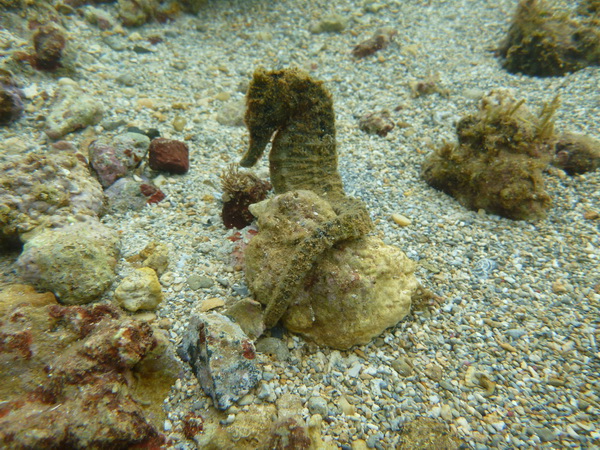Published in the Ocean Watch column, Honolulu Star-Advertiser © Susan Scott
January 30, 2012

My column last week about my fine day on the North Shore prompted several emails from readers asking if I would please share the location of my newly discovered sea horse pasture.
Oh, dear. Should I tell or should I not?
The Waikiki Aquarium does not. In a 2009 UH newsletter, the aquarium’s sea horse biologist reports Oahu sightings of these uncommon fish in ankle-deep water at a popular beach, in harbors and under piers. “Sorry,” the report says, “the aquarium keeps precise locations quiet lest collectors deplete populations once more.”
Sea horses in Hawaii were once so rare that even we frequent snorkelers and divers never expected to see one. Marine guide author John Hoover found a sea horse in Kaneohe Bay and didn’t see another for 20 years.
But over the last few years, sea horse sightings here have been on the rise. Researchers wondered whether these might be the offspring of alien species released by aquarium keepers who gave up the hobby. To answer that question (and others about taxonomy), biologists from the Hawaii Institute of Marine Biology and Bishop Museum collected 32 live sea horses around Oahu and two in Hilo Bay. Using nonlethal techniques, the scientists extracted tissue to check the little darlings’ DNA.
The jury is in. The researchers report in a 2011 issue of Marine Biology Research that the DNA samples of all 34 live sea horses are identical to the DNA of a Bishop Museum-preserved sea horse collected off Oahu in 1901. This DNA was compared with a Singapore sea horse and proved to be unique to the Hawaii individuals, adding another name to our impressive list of species found only in Hawaii.
No one knows whether the current sea horse bloom is due to ideal conditions or if the species is rebounding after being collected to near-oblivion. In either case it’s crucial for sea horse survival that people leave the fish where they find them. Populations are severely depleted due to demand as medicine in Asia and pets in aquariums. In 2004 sea horses became the first commercially valuable genus to be protected under the Convention of International Trade in Endangered Species (CITES).
Hawaii’s sea horses live for about two years, dangling from rocks or seaweed to catch animal food that swims or drifts past. Their only defense is camouflage.
One reader wrote me that he took home two sea horses he found in Kailua waters but returned them when he wasn’t sure how to take care of them. The man did the right thing, but still. His letter and one from another Oahu aquarist made me see that I should follow the Waikiki Aquarium’s no-tell policy. This goes against my grain, but I think it’s the right thing for the sea horses.
To the marine wildlife fans who wrote me about longing to see a sea horse in the wild: I hear you. I am hoping that my silence on their exact location boosts the fish’s odds of staying in the ocean to spew out their babies (100 to 200 each). This increases the likelihood of people having one of those jump-for-joy moments while snorkeling.
We can help Hawaii’s sea horses by sharing our stories and pictures of them but not sharing their addresses. Get wet and look sharp.
©2012 Susan Scott